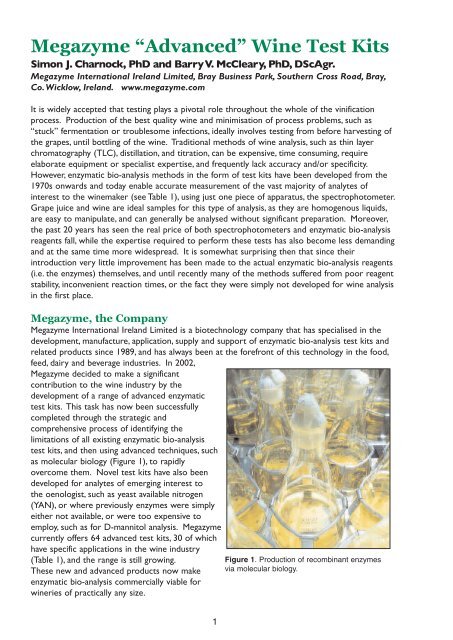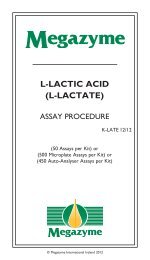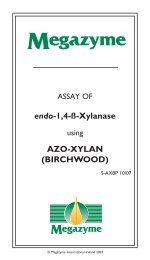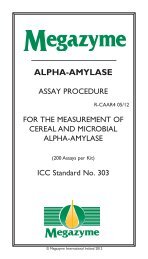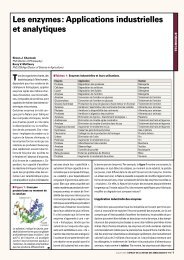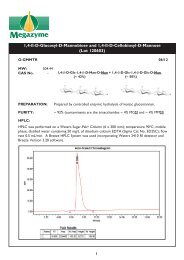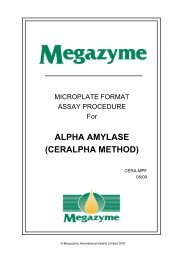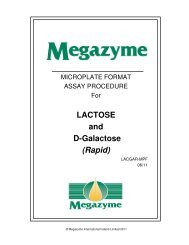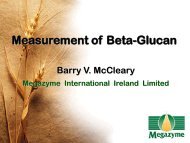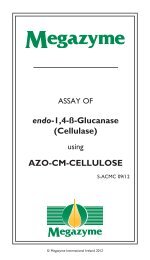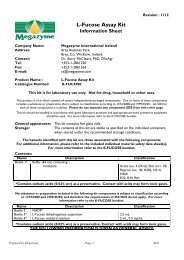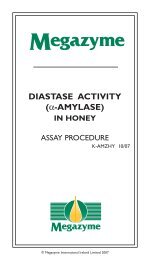Create successful ePaper yourself
Turn your PDF publications into a flip-book with our unique Google optimized e-Paper software.
<strong>Megazyme</strong> “Advanced” <strong>Wine</strong> <strong>Test</strong> <strong>Kits</strong><br />
Simon J. Charnock, PhD and Barry V. McCleary, PhD, DScAgr.<br />
<strong>Megazyme</strong> International Ireland Limited, Bray Business Park, Southern Cross Road, Bray,<br />
Co.Wicklow, Ireland. www.megazyme.com<br />
It is widely accepted that testing plays a pivotal role throughout the whole of the vinification<br />
process. Production of the best quality wine and minimisation of process problems, such as<br />
“stuck” fermentation or troublesome infections, ideally involves testing from before harvesting of<br />
the grapes, until bottling of the wine. Traditional methods of wine analysis, such as thin layer<br />
chromatography (TLC), distillation, and titration, can be expensive, time consuming, require<br />
elaborate equipment or specialist expertise, and frequently lack accuracy and/or specificity.<br />
However, enzymatic bio-analysis methods in the form of test kits have been developed from the<br />
1970s onwards and today enable accurate measurement of the vast majority of analytes of<br />
interest to the winemaker (see Table 1), using just one piece of apparatus, the spectrophotometer.<br />
Grape juice and wine are ideal samples for this type of analysis, as they are homogenous liquids,<br />
are easy to manipulate, and can generally be analysed without significant preparation. Moreover,<br />
the past 20 years has seen the real price of both spectrophotometers and enzymatic bio-analysis<br />
reagents fall, while the expertise required to perform these tests has also become less demanding<br />
and at the same time more widespread. It is somewhat surprising then that since their<br />
introduction very little improvement has been made to the actual enzymatic bio-analysis reagents<br />
(i.e. the enzymes) themselves, and until recently many of the methods suffered from poor reagent<br />
stability, inconvenient reaction times, or the fact they were simply not developed for wine analysis<br />
in the first place.<br />
<strong>Megazyme</strong>, the Company<br />
<strong>Megazyme</strong> International Ireland Limited is a biotechnology company that has specialised in the<br />
development, manufacture, application, supply and support of enzymatic bio-analysis test kits and<br />
related products since 1989, and has always been at the forefront of this technology in the food,<br />
feed, dairy and beverage industries. In 2002,<br />
<strong>Megazyme</strong> decided to make a significant<br />
contribution to the wine industry by the<br />
development of a range of advanced enzymatic<br />
test kits. This task has now been successfully<br />
completed through the strategic and<br />
comprehensive process of identifying the<br />
limitations of all existing enzymatic bio-analysis<br />
test kits, and then using advanced techniques, such<br />
as molecular biology (Figure 1), to rapidly<br />
overcome them. Novel test kits have also been<br />
developed for analytes of emerging interest to<br />
the oenologist, such as yeast available nitrogen<br />
(YAN), or where previously enzymes were simply<br />
either not available, or were too expensive to<br />
employ, such as for D-mannitol analysis. <strong>Megazyme</strong><br />
currently offers 64 advanced test kits, 30 of which<br />
have specific applications in the wine industry<br />
(Table 1), and the range is still growing.<br />
These new and advanced products now make<br />
enzymatic bio-analysis commercially viable for<br />
wineries of practically any size.<br />
Figure 1. Production of recombinant enzymes<br />
via molecular biology.<br />
1
Analyte Cat. No. Oenological Significance 1<br />
Advantages of <strong>Megazyme</strong> <strong>Test</strong> <strong>Kits</strong><br />
Acetaldehyde K-ACHYD<br />
Acetic Acid<br />
1<br />
K-ACET<br />
K-ACETAF<br />
K-ACETAK<br />
Ammonia K-AMIAR<br />
A sensory compound that adds flavour and complexity, but<br />
spoils wine at high concentrations<br />
A sensory compound that adds flavour and complexity in small<br />
amounts, but spoils wine at high concentrations. Produced<br />
naturally by yeast in small amounts and by spoilage organisms<br />
such as Acetobacter aceti in large quantities. This is the<br />
predominant of the acids comprising volatile acidity (VA)<br />
Most important inorganic source of Yeast Available Nitrogen<br />
(YAN)<br />
L-Arginine K-LARGE Most important amino acid in grape juice with respect to YAN<br />
L-Ascorbic Acid K-ASCO Present naturally in grapes and can be added as an anti-oxidant Rapid reaction, stable reagents<br />
Citric Acid K-CITR<br />
Ethanol K-ETOH<br />
Naturally present in small amounts, large amounts indicate<br />
addition for acidification (EU limit is 1 g/L)<br />
Produced during alcoholic fermentation. Amounts > 17.5 %<br />
(v/v) indicate supplementation<br />
AlDH supplied as a stabilised suspension rather than a lyophilised<br />
powder, thus less wasted enzyme<br />
All kits contain PVP to prevent tannin inhibition<br />
1. K-ACET (manual, efficient) contains stable ACS suspension<br />
2. K-ACETAF (auto) used to prepare very stable R1 and R2<br />
3. K-ACETAK (auto) is a new, stable, and very rapid acetate<br />
kinase (AK) based kit with excellent linearity<br />
Novel enzyme employed is not inhibited by tannins, endpoint<br />
reaction time ~ 2 min. Ideal for manual and auto applications<br />
Simple and rapid test kit gives sequential values for ammonia,<br />
urea and L-arginine. No tannin inhibition<br />
Contains PVP to prevent tannin inhibition. Ideal for manual and<br />
auto applications<br />
Rapid reaction, stable reagents (AlDH supplied as a stable<br />
suspension)<br />
D-Fructose / D-Glucose K-FRUGL K-FRGLMQ Grape quality indicator. One of the two principle fermentable<br />
sugars of grape juice<br />
Formic Acid K-FORM Minor wine acid Rapid reaction, stable reagents<br />
D-Gluconic Acid K-GATE Grape quality indicator for the production of certain wines Rapid reaction, stable reagents<br />
D-Glucose<br />
K-GLUC<br />
K-GLUHKR/L<br />
Grape quality indicator. One of the two principle fermentable<br />
sugars of grape juice<br />
Contains PVP to prevent tannin inhibition. Ideal for manual and<br />
auto applications. Stable reagents<br />
Choice of simple formats available, based either on glucose<br />
oxidase/peroxidase, or hexokinase/G-6-PDH<br />
Glycerol K-GCROL Quality indicator of finished wine, important for “mouth-feel” Novel tablet format offers superior stability, rapid reaction<br />
D-Lactic Acid K-DATE Produced predominantly by lactic acid spoilage bacteria Rapid reaction, stable reagents<br />
L-Lactic Acid K-LATE<br />
Produced predominantly from L-malic acid during malolactic<br />
fermentation<br />
D-Malic Acid K-DMAL Only present in significant quantities in adulterated wine<br />
L-Malic Acid<br />
K-LMALR/L<br />
K-LMALAF<br />
K-LMALMQ<br />
D-Mannitol K-MANOL<br />
Primary Amino<br />
Nitrogen (PAN)<br />
K-PANOPA<br />
Grape quality indicator. Very important grape acid, converted<br />
to less acidic L-lactic acid during malolactic fermentation<br />
Produced by spoilage organisms from D-fructose, resulting in<br />
an undesirable “mannitol taint”<br />
Primary amino nitrogen (PAN) is the most important organic<br />
source of Yeast Available Nitrogen (YAN)<br />
D-Sorbitol K-SORB High levels indicate addition of fruit<br />
Rapid reaction, stable reagents. Ideal for manual and auto<br />
applications<br />
D-MDH supplied as a stabilised suspension rather than a<br />
lyophilised powder, thus less wasted enzyme<br />
All kits contain PVP to prevent tannin inhibition<br />
1. K-LMALR/L (manual) rapid reaction<br />
2. K-LMALAF (auto) rapid reaction, excellent linearity<br />
3. K-LMALMQ (manual, colorimeter based)<br />
Novel kit, rapid reaction, stable reagents, simple format<br />
Novel kit, rapid reaction, stable reagents, simple format<br />
Diaphorase supplied as a stabilised suspension rather than a<br />
lyophilised powder, thus less wasted enzyme<br />
Succinic Acid K-SUCC <strong>Wine</strong> acid produced during fermentation Rapid reaction (even at 25 o C), stable reagents<br />
Sucrose<br />
K-SUFRG<br />
K-SUCGL<br />
Urea K-URAMR<br />
Added to increase the amount of alcohol. Use only permitted in<br />
certain situations<br />
Source of YAN and precursor of the carcinogen ethyl<br />
carbamate. Over-supplementation with DAP can result in<br />
elevated levels<br />
Choice of simple formats available, based either on glucose<br />
oxidase/peroxidase, or hexokinase/G-6-PDH<br />
Simple and rapid test kit gives sequential values for ammonia and<br />
urea. No tannin inhibition<br />
Table 1. Advantages of <strong>Megazyme</strong> test kits in the measurement of key wine analytes.<br />
2
The <strong>Megazyme</strong> Advantage<br />
In general, <strong>Megazyme</strong> test kits are ideal for<br />
wine analysis because they have long shelf<br />
lives (spanning at least two vintages), rapid<br />
analysis times (often only a few minutes),<br />
simple formats, and very competitive pricing.<br />
Furthermore, each test kit is under continual<br />
scrutiny and re-evaluation by our very<br />
experienced R&D team. As all test kits have<br />
been developed by the company, our research<br />
scientists are ideally positioned to offer the<br />
very best and rapid customer support.<br />
Recently, with the customer in mind, a range<br />
of calculation aids (MegaCalc) based on<br />
Microsoft EXCEL were developed, which<br />
enable hassle-free and rapid processing of<br />
raw absorbance data for all manual analysis<br />
test kits (Figure 2). These calculators are<br />
offered free of charge on the <strong>Megazyme</strong><br />
website (www.megazyme.com), and can be<br />
downloaded for added convenience.<br />
Figure 2. The MegaCalc TM raw absorbance data<br />
processing aid for YAN determination using the L-arginine /<br />
urea / ammonia, and primary amino nitrogen test kits. Blank<br />
absorbance values are entered at the top of the page where<br />
indicated. After absorbance values are entered for the<br />
ammonia, urea, L-arginine and primary amino nitrogen<br />
reaction endpoints, the EXCEL based program automatically<br />
calculates values for these individual analytes in g/L and also a<br />
total YAN value in mg N/L.<br />
What Laboratory Equipment is Required?<br />
In addition to a spectrophotometer or in some cases a colorimeter, very little laboratory<br />
equipment is actually required. A set of pipettes with disposable plastic tips to accurately dispense<br />
volumes between 20 µL and 1000 µL is necessary, along with plastic cuvettes or glass test-tubes<br />
(depending on the absorbance measuring device used), and basic filtering or other simple sample<br />
treatment apparatus may also be necessary.<br />
Advanced Features of <strong>Megazyme</strong> <strong>Test</strong> <strong>Kits</strong><br />
In addition to the general advantages of <strong>Megazyme</strong> test kits as detailed above, many products<br />
possess special features resulting from their custom optimisation for wine analysis. These features,<br />
briefly detailed in the last column of Table 1, are discussed in detail below:<br />
1. Reagent Stability<br />
(a) Stabilised Enzyme Suspensions: Although the shelf life of many test kits as purchased<br />
appears satisfactory, once used for the first time, certain enzyme components can be very labile.<br />
For example, all acetic acid kits except that supplied by <strong>Megazyme</strong> (K-ACET), employ a freezedried<br />
enzyme component, acetyl-coenzyme A synthetase (ACS). Once reconstituted, this enzyme<br />
can only be used within a very limiting time period, e.g. just 5 days in some cases, after which it<br />
must be discarded. This severe limitation was identified by <strong>Megazyme</strong> and an ACS identified that<br />
could be stabilised by the optimum and preferred technique of ammonium sulphate precipitation.<br />
Not only has this resulted in the <strong>Megazyme</strong> kit being more user friendly and flexible, but it also,<br />
and more importantly, gives the kit a much longer shelf life during use of > 2 years. The same<br />
stabilisation technique was also employed in the optimisation of the acetaldehyde (K-ACHYD),<br />
D-malic acid (K-DMAL), and sorbitol (K-SORB) kits.<br />
3
(b) Reagent Tablets: Some test kits require the use of labile substrates such as ATP. The<br />
glycerol kit is a good example, and the stability of prepared reagent for some competitor kits is<br />
very poor, e.g. just 4 days. <strong>Megazyme</strong>’s glycerol kit (K-GCROL), however, contains these labile<br />
components in a novel dry tablet form, and thus their stability is no longer an issue, as only<br />
sufficient reagent for the analyses in hand need be prepared. Additionally, in order to ensure<br />
maximum stability of the reagents, the tablets are enclosed within special “desiccant impregnated”<br />
vials. These vials, designed especially for this application, are also used with other reagent tablets,<br />
such as in the ammonia (K-AMIAR), citric acid (K-CITR), L-arginine / urea / ammonia (K-LARGE),<br />
primary amino nitrogen (K-PANOPA), and urea / ammonia (K-URAMR) kits.<br />
(c) Stabilisation System: Acetic acid is a major<br />
quality indicator of wine and is monitored throughout<br />
the winemaking process. However, reagent prepared<br />
for auto-analyser applications using ACS based kits has<br />
very poor stability (as little as one day even when<br />
refrigerated), owing to an increasing absorbance value.<br />
This phenomenon was researched at <strong>Megazyme</strong> and a<br />
way found to overcome this major limitation (Figure 3),<br />
giving reagent R1 prepared from K-ACET or<br />
K-ACETAF a stability of up to 7 days at 4°C.<br />
2. Sample Interference Prevention<br />
(a) Enzyme Selection: Most competitor products<br />
are based on the use of enzymes, many of animal<br />
origin, that were developed in some cases as far back<br />
as the 1960s. Although such enzymes generally<br />
perform satisfactorily, problems can arise when<br />
analysing wine. One example is the use of beef liver<br />
glutamate dehydrogenase in the measurement of<br />
ammonia. This enzyme can be significantly inhibited by<br />
tannins leading to either long or incomplete reactions.<br />
Using the molecular biology approach, <strong>Megazyme</strong><br />
rapidly screened many different recombinant (not of<br />
animal origin) enzymes in order to identify one that<br />
does not exhibit tannin inhibition. This approach was<br />
successful, and the result is a very rapid (~ 3 min;<br />
Figure 4), and reliable advanced ammonia test kit<br />
(K-AMIAR).<br />
(b) Inclusion of Polyvinylpyrollidone (PVP):<br />
It is well known that tannins can cause inhibition of<br />
test kit enzymes, and that this can affect the obtained<br />
results. It is also known that PVP can be employed to<br />
prevent/minimise such interference. However, other<br />
test kit manufacturers do not appear to include PVP<br />
in their products, and instead it is left to the customer<br />
to add it into the assay system. Thus for added<br />
convenience and assurance, <strong>Megazyme</strong> has formulated<br />
optimised quantities of PVP into the relevant wine<br />
test kits, namely the acetic acid<br />
Reagent absorbance, 340 nm<br />
0.6<br />
0.5<br />
0.4<br />
0.3<br />
0.2<br />
0.1<br />
0<br />
0 10 20 30 40 50<br />
Incubation time at room temperature, h<br />
Figure 3. Stabilised advanced acetic acid kit<br />
reagent. Both basic (open circles) and stabilized<br />
(closed circles) acetic acid kit reagents were<br />
prepared for auto-analyer applications and<br />
incubated at room temperature (~ 22.5°C). At<br />
time points (0 h, 18 h and 41.5 h) the absorbance<br />
of the reagents was determined. Over this time<br />
period, equivalent to ~ 6 days at 4°C, the<br />
absorbance of the stabilized reagent at 340 nm<br />
only increased by 0.018, while that of the<br />
unstable basic reagent had increased by 0.495.<br />
1.8<br />
1.6<br />
1.4<br />
1.2<br />
1<br />
0.8<br />
0.6<br />
0.0 4.0 8.0 12.0 16.0 20.0 24.0<br />
Incubation time, min<br />
Figure 4. Analysis of red wine for ammonia<br />
using beef liver and recombinant GlDH. The<br />
same amount of red wine was analysed using a<br />
traditional ammonia test kit employing beef liver<br />
GlDH (closed black triangles) and a rapid<br />
advanced product from <strong>Megazyme</strong> employing a<br />
recombinant enzyme (closed red circles). The<br />
end of the reaction is indicated when no further<br />
fall in absorbance occurs, i.e. after only ~ 3 min<br />
with the <strong>Megazyme</strong> kit.<br />
4
(K-ACET, K-ACETAF, K-ACETAK), L-malic acid (K-LMALR, K-LMALL, K-LMALAF), D-fructose/<br />
D-glucose (K-FRUGL), and citric acid (K-CITR) kits (Table 1).<br />
3. Simplified Formats<br />
Most test kit manufacturers offer just one single test kit for each analyte, e.g. for L-malic acid.<br />
However, there are actually many different types of user, each with very different requirements and<br />
available resources. <strong>Megazyme</strong> thus developed specific test kits with each type of end-user in<br />
mind, leading to simple and easy to use formats that require no adaptation by the customer:<br />
(a) Manual Format <strong>Test</strong> <strong>Kits</strong>: This is the most<br />
popular method of analysis for the average<br />
winery possessing a standard spectrophotometer and<br />
a test kit is available for each analyte (Table 1).<br />
(b) MegaQuant TM Format <strong>Test</strong> <strong>Kits</strong>: <strong>Test</strong>ing by<br />
small wineries and grape growers was until recently<br />
very difficult, as such companies generally do not even<br />
possess a basic spectrophotometer, and thus must rely<br />
either on traditional techniques or central<br />
laboratories for their analytical requirements.<br />
However, in response to this pressing requirement, a<br />
novel product was recently launched called<br />
MegaQuant TM , that allows rapid and specific<br />
measurement of both L-malic acid (K-LMALMQ,<br />
G-LMALMQ) and D-glucose plus D-fructose<br />
(K-FRGLMQ, G-FRGLMQ), without the requirement<br />
for an expensive spectrophotometer or other<br />
specialised laboratory apparatus and skills (Figure 5).<br />
(c) Analyser Format <strong>Test</strong> <strong>Kits</strong>: It is common<br />
practice for analysts to purchase standard test kits<br />
and adapt them to a particular auto-analyser.<br />
However, this takes time and the form and quantities<br />
of the individual components is often less than<br />
optimal, leading to significant waste or inconvenience.<br />
<strong>Megazyme</strong> thus developed optimised “analyser<br />
formats” for existing manual kits that are simple to<br />
use and result in no wastage of kit reagents. Where<br />
existing kits could not be employed, new kits were<br />
developed as necessary. Analyser formats are now<br />
available for acetic acid (K-ACETAF, K-ACETAK),<br />
ammonia (K-AMIAR), citric acid (K-CITR), D-fructose<br />
and D-glucose (K-FRUGL), glycerol (K-GCROL),<br />
Figure 5.The MegaQuant TM Meter and reagents<br />
for L-malic acid analysis.<br />
0<br />
0 5 10 15 20 25<br />
L-lactic acid (K-LATE) and L-malic acid (K-LMALAF) analyses, and offer excellent prepared reagent<br />
stability and performance linearity (Figure 6). In addition to test kits, <strong>Megazyme</strong> also offers a range<br />
of individual kit components for those customers who wish to formulate their own reagents. This<br />
is becoming increasingly popular by the experienced auto-analyst, and rapid assistance is available<br />
from the technical support team at <strong>Megazyme</strong> for such custom method developments.<br />
Change in absorbance at 340 nm<br />
1.4<br />
1.2<br />
1<br />
0.8<br />
0.6<br />
0.4<br />
0.2<br />
µg of acetic acid/mL of final reaction solution<br />
R 2 = 0.9997<br />
Figure 6. Linear calibration curves for<br />
<strong>Megazyme</strong>’s stable acetate kinase format acetic<br />
acid kit. After incubation of prepared reagents for<br />
40.5 h at room temperature (~ 22.5°C),<br />
<strong>Megazyme</strong>’s advanced acetate kinase format acetic<br />
acid kit gave an essentially identical<br />
linear calibration curve to that obtained at time<br />
0 h (graphs are superimposed).<br />
5
4. Novel Method Development<br />
(a) Yeast Available Nitrogen (YAN): Before alcoholic fermentation can begin, the<br />
oenologist must establish the nutritional status of the juice, in order to assess whether<br />
supplementation is required. This very important process includes the estimation of YAN. This is<br />
perhaps the most crucial parameter measured during the vinification process, 1 as too little YAN<br />
may result in sluggish or stuck fermentation, with potentially disastrous consequences for wine<br />
quality, while unnecessary supplementation with di-ammonium phosphate (DAP), can result in a<br />
reduction in wine stability and the production, in certain cases, of the known carcinogen, ethyl<br />
carbamate. 2 YAN is comprised of three principle components, free ammonium ions, primary<br />
amino nitrogen (PAN, from amino acids) and the contribution made by the side-chain of L-arginine.<br />
To enable YAN to be quantified accurately, two test kits were developed; the primary amino<br />
nitrogen kit (K-PANOPA) is a simplified and optimised version of the original Dukes and Butzke<br />
method, 3 while the L-arginine / urea / ammonia kit (K-LARGE) is a rapid sequential method based<br />
on the novel glutamate dehydrogenase employed in the ammonia kit (K-AMIAR), that can be<br />
performed in < 16 min (Figure 7).<br />
(b) Acetate Kinase Based Acetic Acid<br />
Kit: In response to calls from the wine<br />
industry, <strong>Megazyme</strong> developed an advanced and<br />
very rapid test kit for acetic acid based on the<br />
enzyme acetate kinase. As can be appreciated<br />
from Figure 6, this product, that has already<br />
become very popular, offers both excellent<br />
stability and linearity.<br />
Future <strong>Test</strong> Kit Development<br />
<strong>Megazyme</strong> remains committed to working with<br />
the oenologist to develop novel test kit<br />
solutions to emerging challenges presented by<br />
the modern wine industry.<br />
References<br />
1. Martin, O., Brandriss, M. C., Schneider, G.<br />
& Bakalinsky, A.T. (2003). Improved anaerobic<br />
use of arginine by Saccharomyces cerevisiae.<br />
App. Env. Microbiol. 69, 1623-1628.<br />
2. Butzke, C. E. & Bisson, L. F. (1997). USFDA<br />
Center for Food Safety and Applied Nutrition,<br />
“Ethyl Carbamate Preventative Action Manual”.<br />
0<br />
0.0 4.0 8.0 12.0<br />
3. Dukes, B. & Butzke, C. (1998). Rapid determination of primary amino acids in grape juice using<br />
an o-phthaldialdehyde / N-acetyl-L-cysteine spectrophotometric assay. Am. J. Enol.Vitic. 49,<br />
125-134.<br />
1.5<br />
1<br />
0.5<br />
Ammonia Urea L-Arginine<br />
Incubation time, min<br />
16.0<br />
Figure 7. Performance of a sequential rapid enzymatic<br />
test kit for L-arginine, urea and ammonia. The sequential<br />
reaction shown demonstrates that L-arginine, urea and<br />
ammonia can be determined using the same cuvette<br />
(closed circles), with reference to a blank containing no<br />
sample (open circles). Individual endpoints for ammonia,<br />
urea and L-arginine, after the addition of recombinant<br />
GlDH, urease and arginase, respectively, are indicated by<br />
arrows. The total analysis time is < 16 min.<br />
6
April, 2006<br />
<strong>Megazyme</strong> Assay <strong>Kits</strong>, Enzymes and<br />
Reagents for the <strong>Wine</strong> Industry<br />
Since 1989, <strong>Megazyme</strong> has developed a world-wide reputation for the purity of the enzymes it<br />
supplies and the quality and innovative nature of the diagnostic kits it develops and supplies.<br />
<strong>Megazyme</strong> now offers the largest range of enzymatic test kits for food, feed and<br />
beverage analysis, with the following kits, enzymes and reagents being specifically<br />
tailored for the wine industry:<br />
DIAGNOSTIC KITS<br />
Cat. No. Analyte No. of Assays<br />
K-ACHYD Acetaldehyde 50<br />
K-ACET Acetic Acid 53<br />
K-ACETAF Acetic Acid (AF) 550<br />
K-ACETAK Acetic Acid (AK) 550<br />
K-AMIA Ammonia 100<br />
K-AMIAR Ammonia (Rapid) 96<br />
K-LARGE L-Arginine/Urea/Ammonia (Rapid) 50<br />
K-ASCO L-Ascorbic Acid 40<br />
K-CITR Citric Acid 72<br />
K-ETOH Ethanol 60<br />
K-FRUGL D-Fructose/D-Glucose 110<br />
K-FRGLMQ D-Fructose/D-Glucose<br />
(MegaQuant TM Format) 60<br />
K-GATE D-Gluconic Acid 60<br />
K-GLUC D-Glucose (GOPOD) 600<br />
K-GLUHK D-Glucose (HK Format) 110 or 220<br />
K-GCROL Glycerol 70<br />
K-ISOC D-Isocitric Acid 100<br />
K-DLATE D-/L-Lactic Acid 100<br />
K-DATE D-Lactic Acid 50<br />
K-LATE L-Lactic Acid 50<br />
K-DMAL D-Malic Acid 100<br />
K-LMAL L-Malic Acid 58 or 116<br />
K-MALAF L-Malic Acid (AF) 1,380<br />
K-LMALMQ L-Malic Acid<br />
(MegaQuant TM Format) 60<br />
K-MANOL D-Mannitol/L-Arabitol 60<br />
K-PANOPA Primary Amino Nitrogen 100<br />
K-SORB D-Sorbitol/Xylitol 58<br />
K-SUCC Succinic Acid (Rapid) 20<br />
K-SUFRG Sucrose/D-Fructose/D-Glucose 100<br />
K-SUCGL Sucrose/D-Glucose 250<br />
K-TSTA Total Starch 100<br />
K-URAMR Urea/Ammonia (Rapid) 100<br />
REAGENTS<br />
Cat. No. Product Amount<br />
R-ATP20 Adenosine 5’-triphosphate 20 g<br />
R-ATP100 Adenosine 5’-triphosphate 100 g<br />
R-NAD5 β-NAD + 5 g<br />
R-NAD25 β-NAD + 25 g<br />
R-NADP2 β-NADP + 2 g<br />
R-NADP10 β-NADP + 10 g<br />
R-NADH2 β-NADH 2 g<br />
R-NADH10 β-NADH 10 g<br />
ENZYMES<br />
E-ACKEC Acetate kinase 100,000 U<br />
E-ACSBS Acetyl-CoA synthetase 250 U<br />
E-GPDH5 Glucose-6-P dehydrogenase 5,000 U<br />
E-GPDH25 Glucose-6-P dehydrogenase 25,000 U<br />
E-GLDHEC Glutamate dehydrogenase<br />
(not inhibited by tannins) 10,000 U<br />
E-GOTEC Glutamate-oxaloacetate transaminase<br />
5,000 U<br />
E-HEX10 Hexokinase 10,000 U<br />
E-HEX50 Hexokinase 50,000 U<br />
E-HKGDH Glucose-6-P dehydrogenase (210 U/mL)<br />
+ Hexokinase (420 U/mL) 10 mL<br />
E-DLDHLM D-Lactate dehydrogenase 15,000 U<br />
E-LMDHEC L-Malate dehydrogenase 50,000 U<br />
E-PGIEC Phosphoglucose isomerase 10,000 U<br />
E-PGIECB Phosphoglucose isomerase 50,000 U<br />
GENERAL<br />
G-LMALMQ<br />
MegaQuant TM Meter<br />
+ L-Malic Acid reagents (60 tests)<br />
G-FRGLMQ MegaQuant TM Meter<br />
+ D-Glucose/D-Fructose reagents<br />
(60 tests)<br />
GC-GLY200 Glycylgolcine buffer 200 g<br />
© <strong>Megazyme</strong> International Ireland Limited 2005<br />
7
REFERENCES:<br />
1. Nissen, A. M.,Anker, L., Munk, N. & Krebs Lange, N. (1992). Xylanases for the<br />
pulp and paper industry. In Xylans and Xylanases (Visser, J., Beldman, G., Kustersvan<br />
Someren, M.A. & Voragen,A. G. J. Eds) Elsevier Science Publishers,<br />
Amsterdam, pp. 325-338.<br />
2. Bailey, M. J. (1988).A note on the use of dinitrosalicylic acid for determining the<br />
products of enzymatic reactions. Applied Microbiology and Biotechnology 29,<br />
494-496.<br />
3. McCleary, B.V. & Monaghan, D. (1999). New developments in the measurement of<br />
α-amylase, endo-protease, β-glucanase and β-xylanase. In Proceedings of the Second<br />
European Symposium on enzymes in grain processing (M.Tenkanen Ed.) VTT<br />
Information Service, pp 31-38.<br />
4. Buckee, G. K. & Baker, C. D. (1988). Collaborative trial on the determination of<br />
β-glucanases in malt by viscometric and dye-labelled methods. J. Inst. Brew. 96,<br />
387-390.<br />
5. Somogyi, M. (1960). Modifications of two methods for the assay of amylase.<br />
Clinical Chem. 6, 23-35.<br />
<strong>Megazyme</strong> International Ireland Ltd.,<br />
Bray Business Park, Bray,<br />
Co.Wicklow,<br />
IRELAND<br />
Telephone: (353.1) 286 1220<br />
Facsimile: (353.1) 286 1264<br />
Internet: www.megazyme.com<br />
E-Mail: info@megazyme.com<br />
WITHOUT GUARANTEE<br />
The information contained in this booklet is, to the best of our knowledge, true and accurate, but<br />
since the conditions of use are beyond our control, no warranty is given or is implied in respect of<br />
any recommendation or suggestions which may be made or that any use will not infringe any patents.<br />
15


